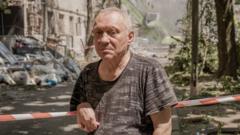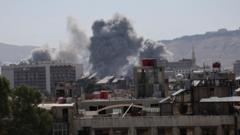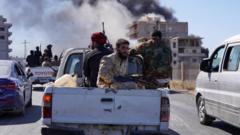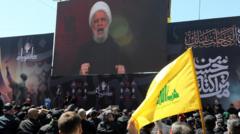Witness accounts reveal the chaotic moments following the strikes, highlighting the urgent need for international aid and support.
Devastation in Kyiv: Rescue Efforts Continue After Lethal Missile Strikes

Devastation in Kyiv: Rescue Efforts Continue After Lethal Missile Strikes
In a brutal nighttime attack, Kyiv faced a barrage of missiles that left at least 30 dead and many injured, as rescue operations still seek survivors.
After a night of horror that struck the Ukrainian capital, Kyiv is reeling from a vicious wave of missile attacks that culminated in a catastrophic airstrike. In the early hours of Tuesday, a cruise missile tore into a residential building in the Solomianskyi district, destroying an entire section and leaving a trail of devastation. Eyewitnesses like Evhen Povarenkov described the moment the missile hit, stating, "There was heat, fire, and smoke," as he recounted the chaos that followed.
As the sun rose the following day, emergency services mobilized in an extensive search and rescue operation. By Wednesday, authorities confirmed that at least 23 lives had been lost, with more bodies expected to be discovered under the rubble. Overall, the attack claimed a total of 30 lives across Ukraine, with most of the fatalities concentrated in Kyiv.
The city's airspace was invaded by a combination of over 440 drones and 32 missiles, as reported by Ukrainian air defense. The strikes lasted for nine grueling hours, marking one of the most aggressive attacks since the onset of the Russian invasion. Among those injured, hundreds required immediate medical attention, including elderly residents who had no means to reach safety quickly.
In the aftermath, health professionals at the Kyiv City Clinical Hospital reported treating victims aged between 18 and 95. "The injuries varied from minor soft tissue lacerations to severe traumatic brain injuries," said Dr. Serhii Dubrov, who oversaw the treatment of dozens of patients arriving post-attack.
The missile strike's timing coincided with President Volodymyr Zelensky's trip to the G7 summit in Canada, leading some to speculate that the attacks were intentionally orchestrated as a message from Russia. This assault underscored Kyiv's urgent need for enhanced international support and air defense systems.
While rescue operations continued, grief-stricken community members gathered to pay their respects at memorial sites, leaving flowers for those who lost their lives. Throughout the area, disoriented and injured residents began to sift through the remnants of their homes, as the pervasive questions of loss and survival lingered in the air.
As the sun rose the following day, emergency services mobilized in an extensive search and rescue operation. By Wednesday, authorities confirmed that at least 23 lives had been lost, with more bodies expected to be discovered under the rubble. Overall, the attack claimed a total of 30 lives across Ukraine, with most of the fatalities concentrated in Kyiv.
The city's airspace was invaded by a combination of over 440 drones and 32 missiles, as reported by Ukrainian air defense. The strikes lasted for nine grueling hours, marking one of the most aggressive attacks since the onset of the Russian invasion. Among those injured, hundreds required immediate medical attention, including elderly residents who had no means to reach safety quickly.
In the aftermath, health professionals at the Kyiv City Clinical Hospital reported treating victims aged between 18 and 95. "The injuries varied from minor soft tissue lacerations to severe traumatic brain injuries," said Dr. Serhii Dubrov, who oversaw the treatment of dozens of patients arriving post-attack.
The missile strike's timing coincided with President Volodymyr Zelensky's trip to the G7 summit in Canada, leading some to speculate that the attacks were intentionally orchestrated as a message from Russia. This assault underscored Kyiv's urgent need for enhanced international support and air defense systems.
While rescue operations continued, grief-stricken community members gathered to pay their respects at memorial sites, leaving flowers for those who lost their lives. Throughout the area, disoriented and injured residents began to sift through the remnants of their homes, as the pervasive questions of loss and survival lingered in the air.






















